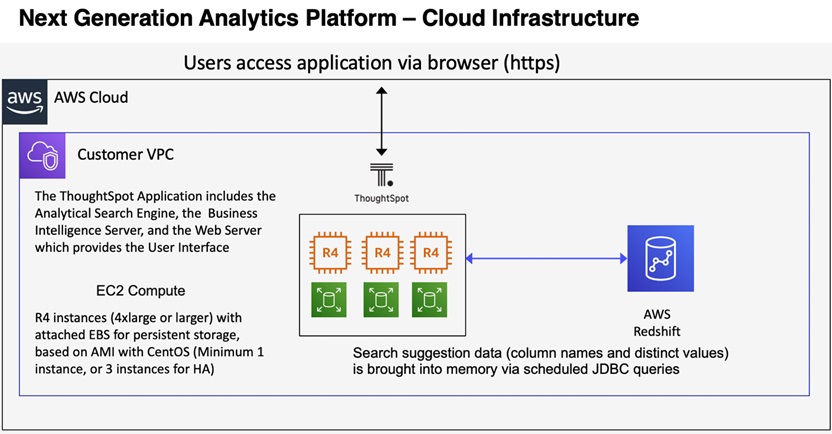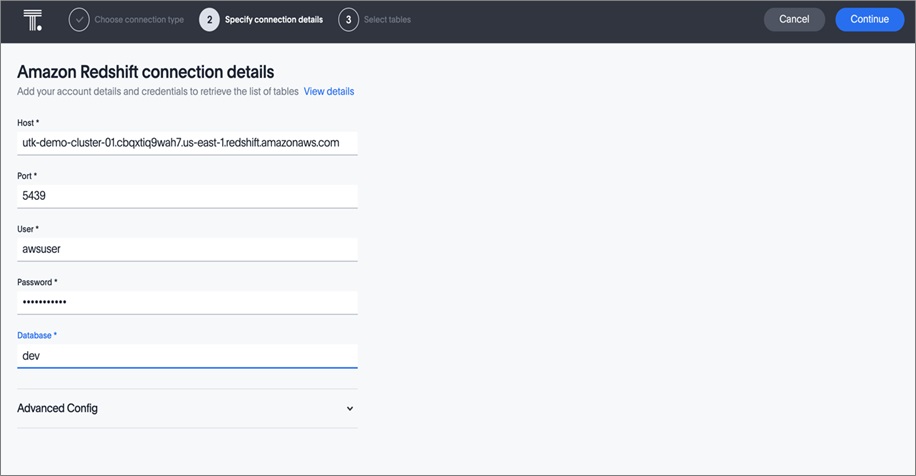AWS Partner Network (APN) Blog
AI-Driven Analytics at Any Scale with ThoughtSpot and Amazon Redshift
By Todd Beauchene, Partner Solution Architect at ThoughtSpot
By Srinivas Kesanapally, Partner Solution Architect at AWS
By Utkarsh Saxena, Software Engineer, Amazon Redshift
 |
 |
 |
As organizations continue to collect increasing amounts of data from a variety of sources, business users—from executives to the field—need ways to access to the data they need to make fact-driven decisions.
However, most decision-makers don’t have time for a three-day training class to learn how to effectively use complex analytics technology. Waiting days for trained analysts to build reports and dashboards slows down decisions.
Luckily, the last few years have seen the emergence of a new paradigm: search and AI-driven analytics. Pioneered by ThoughtSpot, this new approach to analytics lets anyone answer their own data questions in the same way they search for answers online.
With ThoughtSpot, there’s no need for SQL expertise or lengthy training sessions—rather, simple searches are translated into database queries and answers are calculated on-the-fly.
When this paradigm is combined with the power of Amazon Redshift to analyze large volumes of data, decision-makers can answer questions across all their business data.
ThoughtSpot is an AWS Advanced Technology Partner with an AWS Service Ready validation in Amazon Redshift. In this post, we’ll show you how to quickly and easily leverage ThoughtSpot’s search-driven analytics to access data stored in Amazon Redshift.
Chick-fil-A Consumes Data with Embrace for Amazon Redshift
Chick-fil-A is a great example of how easily and quickly organizations can tap the power of ThoughtSpot and Amazon Redshift.
As one of America’s largest fast food chains, Chick-fil-A has tremendous amounts of data ranging from point-of-sale data to mobile app data. They rely heavily on Amazon Web Services (AWS) to securely store and process this data.
A key part of Chick-fil-A’s cloud data strategy is using Amazon Redshift to enable interactive analysis of key datasets, including their supply chain data. With thousands of locations requiring fresh ingredients daily, their supply chain is critical to maintaining their reputation of providing high quality food to customers.
These processes generate millions of rows of data every month. Identifying any issues that could impact a customer’s experience or cause shortages requires timely, granular analysis of all that data
Over the past few years, Chick-fil-A has been using ThoughtSpot in a number of departments to empower business users to get answers to the questions they have about their data. However, adding new datasets to ThoughtSpot was a time-consuming and complex process.
As Chick-fil-A looked for ways to bring supply chain data into ThoughtSpot, they selected Embrace for Amazon Redshift to accelerate and simplify the process.
Chick-fil-A was able to connect directly to their Amazon Redshift cluster and start searching immediately. They now have approximately 40 business users searching across nearly 100 million rows to understand the trends and patterns in their supply chain systems. Even better, they now have a platform that can scale to handle billions of rows and tens of thousands of users across their organization.
“Moving to the cloud and putting the cloud to work are often two different things,” says Callie Cobbs, Sr. Lead Analyst at Chick-fil-A. “That’s why the ease of integrating ThoughtSpot with our existing AWS-based data lakes was so important.
“As our business and data volumes continued to grow, we really needed a platform that would scale as we did, while also giving our business users faster and higher value-add insights to make informed decisions at the speed of business.”
Solution Architecture
ThoughtSpot Embrace for Amazon Redshift gives Chick-fil-A’s business users immediate access to supply chain data. ThoughtSpot users can now access and interactively analyze billions of rows of data stored within Amazon Redshift.
They no longer have the need for analysts to create or modify reports or dashboards that often take days to build or update. By leveraging Amazon Redshift, massive stockpiles of data can be available to meet the goal of providing immediate data access to their business decision makers.
Additionally, they now have a solution that’s flexible and powerful enough to scale as they expand to new use cases.
ThoughtSpot Embrace includes a built-in connector to Amazon Redshift. An administrator can create a connection to any Amazon Redshift instance by providing the URL, a valid username and password, and the database name.
Users can then select the tables within the database they want to enable for search. Once the connection is created, ThoughtSpot uses the Java Database Connectivity (JDBC) API to query table and column names, along with distinct vales, to build a search index.
The search index is used to provide search suggestions within the application, and it’s updated daily.
Once a user searches a dataset stored in Amazon Redshift, ThoughtSpot converts the search into a SQL query formatted for Amazon Redshift that runs the query in real-time. ThoughtSpot interprets the query results and displays the best-fit visualization based on the format of the data.
How to Configure Amazon Redshift in ThoughtSpot
Follow these steps to connect to ThoughtSpot.
- First, log in to ThoughtSpot. Select the Data tab, and then the Connections subtab. Choose Add Connection.
. - In the window that appears, choose Amazon Redshift as the Connection type, and give the connection a descriptive name. Select Continue on the top right corner of the screen.
. - Next, provide credential details such as Amazon Redshift Host name (the cluster end point), Amazon Redshift port, username, password, and database name.
.
You can get these details from the Amazon Redshift console. First, select the region where the cluster resides. From the left side panel, choose the clusters tab. The connection information appears in the connection details section on the lower right side.
The endpoint has the host name, port number, and database name (for example, <host_name>:<port_number>/<database_name>. The user name also appears here along with the option of changing the master user password.
.
Once you have finished entering the credential details, select Continue on the top right corner of the screen.
- Once the connection is established, the option to select the tables appears. These are the tables within the database you will enable for the analytics search.
.
On the left side, the window displays all the schemas that are available in the database. Expand a schema to select a table. After selecting the tables you need, select Create Connection.
- After you create the connection, you can start exploring the data. Here’s an example of the Data window for our sample dataset.
When a user runs a search, ThoughtSpot automatically displays the results using the best-fit visualization. In this case, that results in a bar chart displaying the total profit by manufacturer sorting in descending order.
Conclusion
ThoughtSpot has developed a way for business people to easily answer their own data questions without the need for SQL expertise or lengthy training sessions.
As Chick-fil-A demonstrated, by combining ThoughtSpot search-driven analytics with the power of Amazon Redshift to analyze large volumes of data, you can answer questions across all your business data.
Business users can create a connection from ThoughtSpot to any Amazon Redshift instance by using the ThoughtSpot Embrace connector. You can select individual tables within Amazon Redshift to enable for search.
Once a user searches a dataset stored in Amazon Redshift, ThoughtSpot runs the query in real-time, interprets the query results, and displays the best-fit visualization based on the format of the data.
To get started, create an Amazon Redshift cluster and contact ThoughtSpot to get access to a trial instance. We recommend you take advantage of these resources:
ThoughtSpot – AWS Partner Spotlight
ThoughtSpot is an AWS Advanced Technology Partner that has developed a way for business people to easily answer their own data questions through search-driven analytics.
Contact ThoughtSpot | Partner Overview | AWS Marketplace
*Already worked with ThoughtSpot? Rate the Partner
*To review an AWS Partner, you must be a customer that has worked with them directly on a project.





